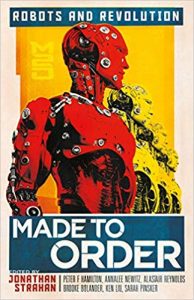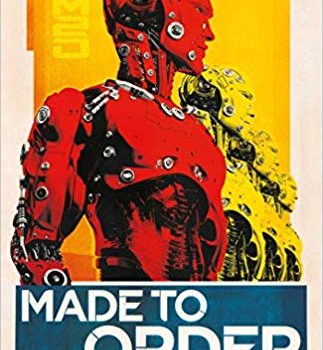Gary K. Wolfe Reviews Made to Order: Robots and Revolution, Edited by Jonathan Strahan
 Made to Order: Robots and Revolution, Jonathan Strahan, ed. (Solaris 978-1781087879, $11.99, 400pp, tp) March 2020.
Made to Order: Robots and Revolution, Jonathan Strahan, ed. (Solaris 978-1781087879, $11.99, 400pp, tp) March 2020.
I suppose it’s both appropriate and inevitable that the coming centennial of Karel Capek’s R.U.R. will have us reconsidering the long and varied history of robots in SF, and an excellent way to start that conversation is by reading Jonathan Strahan’s Made to Order: Robots and Revolution, which brings together 16 original stories from writers long established (Peter F. Hamilton, Alastair Reynolds, Ian McLeod), more recently ascendant (Ken Liu, Annalee Newitz, Brooke Bolander), and broadly international (Vina Jie-Min Prasad, Saad Z. Hossain, Tochi Onyebuchi). Anthologies about robots may be nearly as important in SF history as individual novels and stories, from one of the earliest, Groff Conklin’s 1954 Science-Fiction Thinking Machines (which included Capek’s play, probably presented for the first time in the context of genre SF) to the more recent and playful (such as Dominik Parisien & Navah Wolfe’s Robots vs. Fairies a year or so ago). In his introduction, Strahan argues that the continuing popularity of robots may be partly due to our failure to find evidence of other intelligent life in the universe, and so we create artificial intelligence just to keep from feeling lonely. It’s an intriguing argument, but the sophisticated AIs in the stories he presents – some of which strike disarmingly close to home – suggest there might be another factor at work. There has always been a degree of magical thinking baked into SF’s favorite tropes: of course we’ll be able to travel faster than light, or go back and forth in time, or develop powers of telepathy or telekinesis; we just haven’t figured out how yet. The fact is that we haven’t made significant real-world progress in these areas since they became staples a century or so ago (and we aren’t likely to). With robots, though, what once looked like magical thinking – the casual assumption that if you build something that looks like a human it will be able to think like a human, perhaps aided by a bit of handwaving about positronic brains and such – is already with us in everything from neural networks, to service and manufacturing bots, to remote-controlled weapons. In other words, Conklin’s archaic-sounding “thinking machines” turns out to be one of the few classic SF ideas that doesn’t require a fillip of wishful thinking, that we can actually do something about, and that we in fact already have.
Let’s take that business of remote-controlled weapons, for example. Two of the stories in Made to Order (the title is exactly the pun you think it is) which strike closest to home are Daryl Gregory’s “Brother Rifle” and Tochi Onyebuchi’s “The Hurt Pattern”. In Gregory’s story, a heavily armed wheeled robot called a SHEP is remotely controlled by Rashad, a systems operator for whom choosing targets to shoot is much like a video game. When a sniper kills team members, Rashad’s response is to send the robot into a building, resulting in a massacre and a predictable load of guilt. While much of the story focuses on Rashad’s AI-assisted rehabilitation after a brain injury (ironically, he can no longer make decisions of any kind), the SHEP unit itself is barely SF at all. Similarly, in Onyebuchi’s story, police robots (called “Crusties” from their resemblance to crustaceans) serve as agents of “algorithmic policing” but, among other things, inadvertently kill a 13-year-old boy wielding a hairbrush. Again, the focus is on a human operator, Kenny, monitoring incidents of violence, who becomes aware that the robots actually reduce wrongful-death lawsuits, since human decision-making is replaced by the algorithms. When Kenny learns about the financing behind wrongful-death payouts, he comes to a devastating realization – but again, the robots themselves are very nearly ones that could be deployed today. On the other hand, the police vehicles and monstrous “Beasties” of Peter Hamilton’s cheerfully violent “Sonnie’s Union” – let alone the horror-story prosthetics – are more in keeping with post-Transformer CGI mechazoids, as are the flesh-shredding “bioguns” of Rich Larson’s “An Elephant Never Forgets”, with its echoes of Harlan Ellison nightmares.
The notions of algorithmic policing or algorithmic warfare both reflect an important distinction that earlier SF writers largely ignored, and that is the distinction between the robots themselves and the information-processing AIs that inhabit or control them. In what may be the book’s most provocative and fully thought-out future, Annalee Newitz’s “The Translator”, the United States has been disassembled, California joins the UN, and algorithms – not machines – have been granted civil rights. But – reflecting an idea that’s been popping up for a few years now – the AIs are far more interested in talking to each other than to us, and the narrator is one of a handful of professional translators capable of decoding the AIs’ cryptic and often eccentric modes of communication; using a timeline extending decades, Newitz achieves the expansive feel of a much longer story. Just how AIs might grow their own cultures is explored in Brooke Bolander’s “A Glossary of Radicalization” and Vina Jie-Min Prasad’s “A Guide for Working Breeds”, both of which deal with AIs learning from other AIs. Rhye, the partly biological “Make” in Bolander’s story – she’s fueled by yeast – gradually comes to realize that “we were made like this so they could control us,” and learns of a legendary Make who gained independence after working for a mobster; the story’s main strength is the new twist on the classic idea of artificial people as a potentially subversive underclass. Prasad’s much lighter story, one of the two funniest in the book, is a dialogue between an older AI, calling itself Constant Killer, reluctantly assigned to mentor a newly minted robot who develops an odd obsession with dogs and raccoons while working as a cook in a fast-food restaurant.
The other frankly hilarious story is Saad Z. Hossain’s “The Endless”, probably the only story you’ll ever read narrated by a pissed-off former airport. Set in more or less the same world as Hossain’s The Gurkha and the Lord of Tuesday, with Bangkok managed by a supposedly non-sentient AI named Karma, the story is narrated by that airport AI, now demoted, humiliated, and plotting revenge against both humans and fellow AIs. Like Hossain’s other work, though, there are some provocative ideas behind what amounts to an elaborate caper tale with a neat twist at the end. It reminds us that robots have historically served another function in SF – allowing writers to play with other genres, like Asimov’s famous robot detective. The most direct homage to these classic tales, and one of the most purely delightful here, is Sarah Pinsker’s “Bigger Fish”, with its allusions not only to Asimov and Bradbury but even to Dorothy Sayers. A familiar down-at-the-heels private eye is hired by a wealthy client to investigate his father’s apparent suicide. Pinsker works out the detective story, involving an R2-D2-like service robot and a house AI, with ingenious skill, while implying a larger secret about collective machine intelligence. I wouldn’t mind seeing more stories in this setting.
Most of the other stories concern service robots of one sort or another. Interestingly, the only robot involved in planetary exploration – one area in which we’ve already begun to deploy robots with some success – is the one in Peter Watts’s “Test 4 Echo”. More specifically, it’s one arm of a cephalopodic robot seeking life on Enceladus, which seems to be developing consciousness, creating an existential dilemma for its human and AI operators. Two stories, John Chu’s “Dancing with Death” and Suzanne Palmer’s “Chiaroscuro in Red”, concern robots facing obsolescence, with Chu’s robot given new life as a skating coach. Palmer’s story, in which a student receives an aging factory robot as a gift from his parents, is fascinating not for its rather sad robot facing age discrimination from newer models, but for its picture of a post-scarcity economy in which people can buy into robot labor for income and in which education has been transformed by gaming scenarios. Alastair Reynolds’s “Polished Performance” is a satisfying little-robot-that-could story in which the service robots – including a lowly floor polisher – face a crisis on a decades-long space voyage when they discover that all the human passengers have died. The idea of robots inheriting a post-human Earth underlies Ian R. McLeod’s rather touching “Sin Eater”, with a robot attendant helping prepare the last Pope to join the rest of the population in its new virtual habitat, while Ken Liu’s “Idols”, one of his comparatively few stories to draw upon his experience as an attorney, explores the notion that actual personalities might be reconstructed in digital simulacra or “idols” for various applications, such as jury modeling, celebrity fan service, art, or even personal need, as a narrator uses such an idol to try to connect with a father he never knew.
For me, though, by far the richest exploration of the literary idea of robots in Made to Order is Sofia Samatar’s “Fairy Tales f or Robots”, which inevitably recalls Stanislaw Lem’s “Fables for Robots”, but is far less satiric and more meditative. Told in a dreamy voice that only occasionally verges on cloying, the narrator is a lonely but idealistic designer who is staying overnight at “the Institute” to tell various stories to a robot scheduled to come online the next morning, surreptitiously using stories to give it a chance at growing a unique personality. In what at times reads as much like a literary essay as a SF story, Samatar takes us through 15 classic tales – not only fairy tales but myths, legends, Shakespeare plays, E.T.A. Hoffman’s Sandman and Nutcracker, Pinocchio, and Oz – finding in each an analog or metaphor for aspects of robot-dom, from the idea of being programmed like a Golem, to going into sleep mode like Sleeping Beauty, to the idea of living life as a tool or vessel for the benefit of others. It’s nearly like having many of the ideas in that entire Robots vs. Fairies anthology rolled into one tale, and the importance of compassion – which we eventually learn that the narrator learned through hard experience – gives this anthology-within-a-tale a clear unifying theme. Compassion may not be what all the robots in Made to Order are up to – there’s a fair amount of revenge, moral neutrality, and simply wanting to be left alone – but, as Samatar points out, it’s long been the quality we most need when dealing with beings not like ourselves, whether we made them or not. Overall, Made to Order is a pretty useful guide to how some of our best SF writers are reshaping a classic theme as it moves closer to our own reality.
Gary K. Wolfe is Emeritus Professor of Humanities at Roosevelt University and a reviewer for Locus magazine since 1991. His reviews have been collected in Soundings (BSFA Award 2006; Hugo nominee), Bearings (Hugo nominee 2011), and Sightings (2011), and his Evaporating Genres: Essays on Fantastic Literature (Wesleyan) received the Locus Award in 2012. Earlier books include The Known and the Unknown: The Iconography of Science Fiction (Eaton Award, 1981), Harlan Ellison: The Edge of Forever (with Ellen Weil, 2002), and David Lindsay (1982). For the Library of America, he edited American Science Fiction: Nine Classic Novels of the 1950s in 2012, with a similar set for the 1960s forthcoming. He has received the Pilgrim Award from the Science Fiction Research Association, the Distinguished Scholarship Award from the International Association for the Fantastic in the Arts, and a Special World Fantasy Award for criticism. His 24-lecture series How Great Science Fiction Works appeared from The Great Courses in 2016. He has received six Hugo nominations, two for his reviews collections and four for The Coode Street Podcast, which he has co-hosted with Jonathan Strahan for more than 300 episodes. He lives in Chicago.
This review and more like it in the March 2020 issue of Locus.
 While you are here, please take a moment to support Locus with a one-time or recurring donation. We rely on reader donations to keep the magazine and site going, and would like to keep the site paywall free, but WE NEED YOUR FINANCIAL SUPPORT to continue quality coverage of the science fiction and fantasy field.
While you are here, please take a moment to support Locus with a one-time or recurring donation. We rely on reader donations to keep the magazine and site going, and would like to keep the site paywall free, but WE NEED YOUR FINANCIAL SUPPORT to continue quality coverage of the science fiction and fantasy field.







